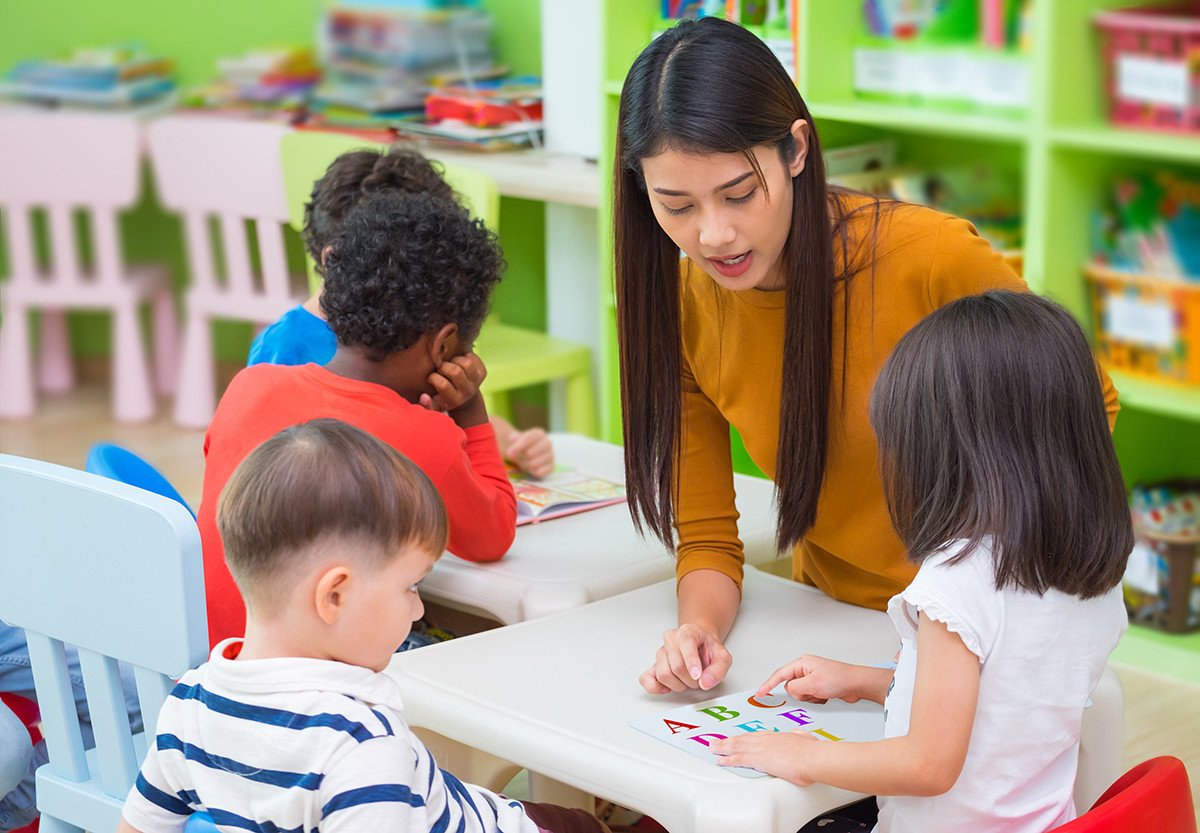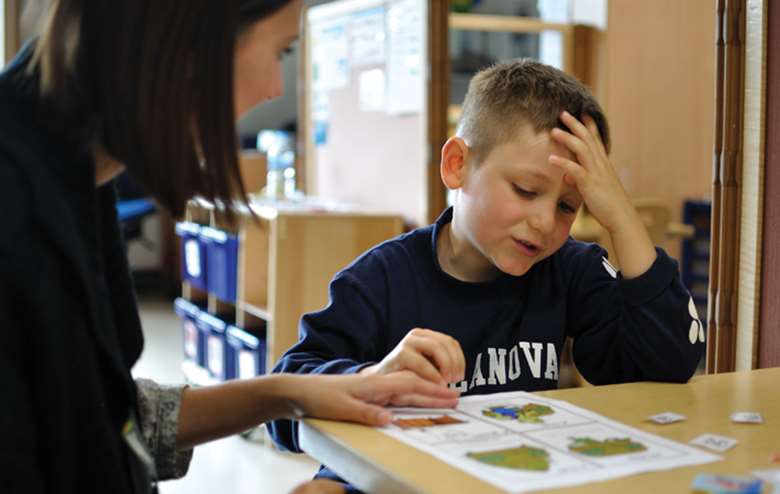Required Services May Be Delivered Online
It might seem reasonable that legal guarantees of services would be suspended during an international pandemic. The reality, however, is that despite extra obstacles and costs, your school district is still required to stick to the IEPthough services may be provided remotely.
Here is what Wrightslaw.com, a site focused on special needs law, says about this issue:
“Many children’s IEPs include related servicesspeech-language therapy, occupational therapy, physical therapy, behavioral therapy, tutoring, counseling, etc. Some school districts advised parents that ‘these services cannot be provided virtually.’ This is not true. School districts can contract with teletherapy companies to provide the speech-language, physical therapy, occupational therapy children with disabilities need to receive a free appropriate public education as set forth in their IEPs.”
Where Do Autism Specialists Work
Typically, autism specialists work in educational settings, such as public and private K-12 classrooms. Students with ASD may be placed in a specific, special education classroom, or they may be a part of a general education classroom and get special assistance from an aide. They may also be sent to a special class for part of the day where they receive additional help.
Certified autism specialists work in any of these settings, either as specialized teachers, general education teachers who can offer specialized instruction for autistic students or assistants in the classroom.
Other professionals can also become autism specialists to get the credentials necessary to work with ASD children. For example, Rago says that private therapists may choose to become specialists in this field, or social workers who have clients with ASD or clients who have children with ASD may want to get this certification. Private aides may also find it helpful to get the certification; these professionals focus not on teaching ASD children, but on supporting their social, emotional, and behavioral needs.
Distract And Redirect Problematic Behavior Instead Of Saying Stop Or No
For example, if the child is running in the store, remind him or show him how to walk nicely. If necessary, find something interesting to show him and call his attention to it, rather than focusing on the problematic behavior. If he is running in the hall at school, redirect him back to the line, with a short directive such as, Come back to your spot in line or remind him to walk in the hallway. For children with trouble understanding language, try demonstrating what is expected or use a gesture, rather than just giving the verbal direction.
Also Check: What Do Autistic Kids Like To Do
Use Special Interests As A Reward
Many kids with autism have special interests or areas of intense focus. These can be very specific, and they may change from time to time as the child matures. Often, these offer a great avenue for interacting, but they can also present a reward system. Set up a chart to allow the child to earn a trinket or experience related to his or her special interest. You can use photos or graphics to help the chart be more motivating.
A Teachers Brief Guide To Teaching Students With High

Learn more about talents and challenges in children with high-functioning autism. Get tips on how to make your classroom welcoming and supportive, including lots of ideas for creating physical and instruictional supports, and how to use specific interests to jumpstart learning adventures with other subjects.
Don’t Miss: Can A Child Outgrow Autism
Board Games With A Twist
Teaching children manners can be a helpful way to boost social skills and explain the importance of being polite. This simple, but effective activity puts an etiquette-related twist on a simple game of chess, checkers, or mancala by requiring players to wish their opponent good luck or good game before and after they have played.
Autism And Social Skills
While no two children with autism are the same, and the range and intensity of symptoms varies from person to person, social dysfunction tends to stand out the most when interacting with a child on the autism spectrum. Some kids find back-and-forth dialogue difficult, preferring to talk only about a topic he or she is interested in, while others prefer to avoid social interactions completely.
To an outsider, it often seems as though these children prefer to play independently, and while that may be the case for some, many kids with autism genuinely want to form friendships with their peers.
They just dont know how to do it!
In the face of communication challenges, sensory processing sensitivities, an inability to express their own emotions and understand the emotions of others, and problems with impulse control and self-regulation, the world is an overwhelming and confusing place for people with autism, and despite their best intentions, they often fall short when it comes to reading social cues and responding appropriately.
The good news is that it IS possible to teach social skills to kids with autism, and we have 25 tips and social skills activities to help.
Read Also: How Do You Get Diagnosed With Autism
Just Like Me Activity
For this activity, gather all of your students together on the floor so they can all see each other. Have each child take turns sharing something about themselves, like:
- I have a pet dog.
- I can play the piano.
- My birthday is in September.
- I love to play soccer.
- My favorite color is yellow.
If a statement also applies to other students , instruct them to raise their hands. This will help remind students that they share more similarities than differences with their peers and that they can always find something to talk about.
Educate Yourself About The Learner
Educating yourself is a practical step for teaching any individual. You need to learn as much about the student as you can to cater and facilitate their needs. If the child has an IEP or 504 plan in place, make sure to study up on these. Knowing the accommodations ahead of time will help with a smooth transition.
If possible, touch base with the childs previous teachers. Chances are, they will have some great insight to help you learn more about your student.
Also Check: What Is The Definition Of Autism
Transition Strategies For Kids With Autism: 10 Tips That Work
This post may contain affiliate links.
While most children struggle with transitions at some point in their lives , children with developmental delays such as autism can find it particularly difficult to move from one activity to another. They may become visibly agitated and overwhelmed, express feelings of sadness and anger, and some may erupt into a full-blown meltdown, especially when they are expected to transition from an activity they enjoy to something less desirable.
When considered from a logical point of view, this inability to cope with change in kids with autism makes perfect sense. Communication challenges, rigidity, sensory problems, emotional difficulties, and cognitive deficiencies can make the lives of children on the autism spectrum extremely confusing and difficult. They depend on predictability and consistency to help make sense of the world around them, and when faced with disruptions, they find it difficult to cope.
Unfortunately, we live in a world where change is inevitable, and learning effective transition strategies for kids with autism can make all the difference in helping to make their lives a little less overwhelming.
Whether youre a parent looking for transition strategies to help your child with autism cope with day-to-day tasks more easily, or a teacher looking for tips and tricks to make classroom transitions easier, weve got 10 brilliant ideas to get you started!
What Autism Has Taught Me
I hope you enjoyed my personal reflection on autism and what autism has taught me. Its a privilege to be able to learn every day from autistic children who experience the world differently. Our NAPA parents online community is filled with stories from parents who have learned acceptance, patience, and the value of reflection from their children. Im honored to have the opportunity to join them.;
About the Author
Allyson Bates is an occupational therapist that works with children with Autism and other diagnoses to promote independence and enjoyment in meaningful daily activities. She was previously an elementary school teacher and now has worked at the Neurological and Physical Abilitation Center for over three years and is passionate about sharing knowledge and research to increase awareness about the kids and families she works with.;
Related Blogs:
Don’t Miss: What Is The Best Pet For An Autistic Child
Here Are Our Top Seven Strategies For Promoting Language Development In Nonverbal Children And Adolescents With Autism:
Job Options Can Depend On Capabilities

The benefits of real experience in the right environment that is specific to the teen cant be overstated. A part-time job gives;teens;the chance to see what work life is like when a parent is not around, Gebura says.
Typically,;autism;programs such as the;Cleveland Clinic Center for;Autism;help teenagers aim for one of three levels of job placement:
- Adult activity centers; These centers offer;development of job training skills;for lower-functioning individuals in a structured, supportive environment.
- Supported employment; Many agencies or offices offer jobs with built-in support systems like job coaches, for example. This is best for individuals who are capable of doing a job but cant necessarily live and/or work independently.
- Competitive employment; This includes truly independent jobs for individuals. Employees must be able to both handle the responsibility of transportation to and from work and day-to-day work activities.
Also Check: How To Discipline An Autistic Boy
Learn How The Child Learns Best
Many kids with autism are visual thinkers and learners and using pictures and other visual aids during teaching is helpful. Visual aids are especially effective when teaching number concepts, directional terms, and word recognition to kids who learn this way. However, not all children on the autism spectrum are visual learners, so it’s essential you determine the best learning style before you begin teaching in a certain way. Take some time to observe the child and experiment with different methods of sharing information.
Social Interaction And Social Learning
Social engagement is important, but it’s hard to set up “lunch bunch” or social skills groups in a virtual environmentespecially for students who find even face-to-face interaction daunting. Fortunately, there are many ways to be social.
Depending on your child’s needs and abilities, they may enjoy:
- Online gaming in virtual worlds or virtual versions of real-world games such as Dungeons and Dragons or chess
- Zoom groups that focus on a special interest, or provide an opportunity for structured interaction
- Family experiences that may have been limited before COVID, such as shared TV time, or shared work on a jigsaw puzzle or board game
You May Like: Does Aba Therapy Work For Mild Autism
What Would You Do
For a take-home activity you can share with families, try this What Would You Do? game. Families can go through different scenarios together and decide how they would react with questions like How would you help? or What would you say?
This activity keeps social skills sharp and reinforces relationship-building skills.
Sorting With Snacks Activity
This tactile activity for children with autism can be a fun way to engage students during math time. Give everyone in your class a food that is easy to sort, like chewy snacks or small crackers. Multicolored snacks are ideal, but you can also use food that comes in different shapes, textures, or sizes.
First, ask them to sort the food by color, shape, or another characteristic. Then, use the snacks to teach students basic math skills like counting, adding, or subtraction. Once theyve grasped the concept you want to teach, reward your students by letting them eat the snack.
Also Check: How To Tell If Youre Autistic
Teaching Nonverbal Autistic Children To Talk
Still among our most popular advice posts, the following article was co-authored by Autism Speaks’s first chief science officer, Geri Dawson, who is now director of the Duke University Center for Autism and Brain Development; and clinical psychologist Lauren Elder.
Researchers published the hopeful findings that, even after age 4, many nonverbal children with autism eventually develop language.;
For good reason, families, teachers and others want to know how they can promote language development in nonverbal children or teenagers with autism. The good news is that research has produced a number of effective strategies.
But before we share our top tips, its important to remember that each person with autism is unique. Even with tremendous effort, a;;strategy that works well with one child or teenager may not work with another. And even though every person with autism can learn to communicate, its not always through spoken language. Nonverbal individuals with autism have much to contribute to society and;can live fulfilling lives with the help of visual supports and assistive technologies.
Calming Activities To Prevent Autism Meltdowns In Class
When students with autism are feeling overwhelmed, the intense response that they feel may cause them to lose control of their emotions. This is called an autism meltdown and is different from when students without autism act out in class. While the best strategy for autism meltdowns is to seek help from a school specialist, these calm down activities can help to de-escalate stressful situations.
You May Like: Is Dr Shaun Murphy Really Autistic
Commonly Used Approaches And Interventions In Haringey
SPELL stands for Structure, Positive approaches and expectations, Empathy, Low arousal, Links. It recognises the individual and unique needs of each child and adult and can also serve as a means for planning and intervention:
One of the benefits of using this framework is that by drawing on a range of approaches it makes sure that the fundamentals of what a child needs in a range of contexts, eg in a 1:1 settings, small groups and in the whole classroom are highlighted and learning can be generalised to all situations. More information about the SPELL framework is available on the NAS and Autism Education Trust websites .
In Haringey, there is a specialist team made up of teachers and education support workers who work with staff in mainstream schools to support children and young people with autism to access the curriculum. All members of this team have received training in SPELL and the framework is used in all aspects of identification, planning and intervention work. An eclectic range of strategies and approaches are used by the team to develop individualised programmes within the SPELL framework. A brief overview of how this approach can be used in schools can be seen on the Autism Education Trust website .
Tell The Child Specifically What You Expect And Allow Him To Earn Privileges For Complying With Your Expectations

For instance, if your child often has a tantrum in a store when he cant go to the toy aisle, tell him exactly what you expect of him before you go to the store and reward him with a privilege for following that expectation. For instance, you can say something like We are going to Target. We are going to the school supply aisle to buy paper and pens, and then we will pay and go home. Once in the store you can give reminders .
Let the child know that he can earn a privilege for following the rules. Privilege ideas include getting a sticker of a favorite character, playing a favorite game once at home, watching a favorite show, going on the computer, staying up ten minutes past bed time, etc. Try to think of a privilege that your child might like or ask him what he would like to work towards.
When the child earns the privilege, praise him with specific language. In the example above you could say, You followed the rules at the Target. We got the paper and pens, paid, and came home. Nice work! Now you can enjoy some computer time. Make sure the privilege is something the child wants. You can let the child choose what he would like to work for ahead of time. Children also benefit from nonverbal praise such as high fives, smiles, thumbs up, etc.
Recommended Reading: What Causes Autism Exploring The Environmental Contribution
Resources Tools And Ideas For Success
Students with autism can thrive during the COVID pandemic. To make that happen, both parents and educators can take advantage of existing resources and opportunitiesand creatively structure the school day to help ensure success.
The reality is that, while some aspects of pandemic schooling are unusually difficult for children on the spectrum, many children are actually doing better during the pandemic than during a typical school year.
Verywell / Brianna Gilmartin